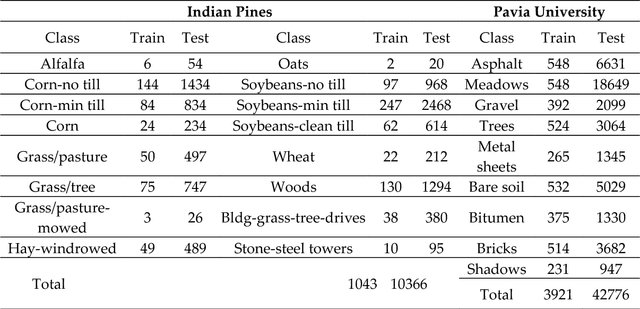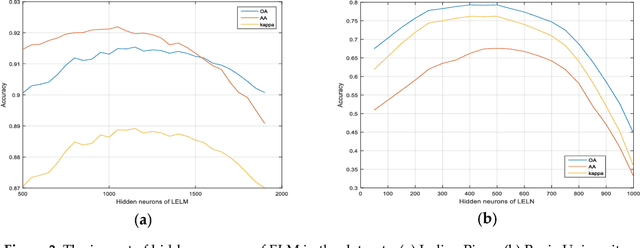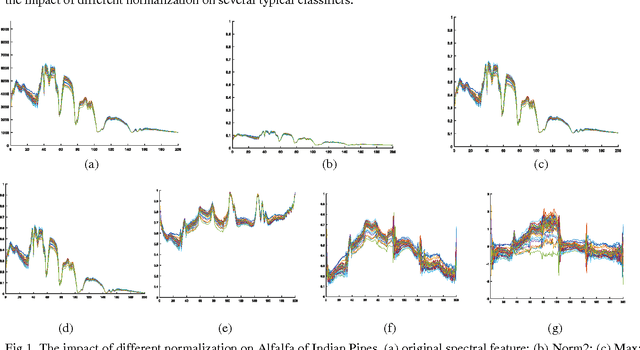Mengying Jiang
Self-Attention Empowered Graph Convolutional Network for Structure Learning and Node Embedding
Mar 06, 2024Abstract:In representation learning on graph-structured data, many popular graph neural networks (GNNs) fail to capture long-range dependencies, leading to performance degradation. Furthermore, this weakness is magnified when the concerned graph is characterized by heterophily (low homophily). To solve this issue, this paper proposes a novel graph learning framework called the graph convolutional network with self-attention (GCN-SA). The proposed scheme exhibits an exceptional generalization capability in node-level representation learning. The proposed GCN-SA contains two enhancements corresponding to edges and node features. For edges, we utilize a self-attention mechanism to design a stable and effective graph-structure-learning module that can capture the internal correlation between any pair of nodes. This graph-structure-learning module can identify reliable neighbors for each node from the entire graph. Regarding the node features, we modify the transformer block to make it more applicable to enable GCN to fuse valuable information from the entire graph. These two enhancements work in distinct ways to help our GCN-SA capture long-range dependencies, enabling it to perform representation learning on graphs with varying levels of homophily. The experimental results on benchmark datasets demonstrate the effectiveness of the proposed GCN-SA. Compared to other outstanding GNN counterparts, the proposed GCN-SA is competitive.
Hierarchical Multi-Relational Graph Representation Learning for Large-Scale Prediction of Drug-Drug Interactions
Feb 28, 2024Abstract:Most existing methods for predicting drug-drug interactions (DDI) predominantly concentrate on capturing the explicit relationships among drugs, overlooking the valuable implicit correlations present between drug pairs (DPs), which leads to weak predictions. To address this issue, this paper introduces a hierarchical multi-relational graph representation learning (HMGRL) approach. Within the framework of HMGRL, we leverage a wealth of drug-related heterogeneous data sources to construct heterogeneous graphs, where nodes represent drugs and edges denote clear and various associations. The relational graph convolutional network (RGCN) is employed to capture diverse explicit relationships between drugs from these heterogeneous graphs. Additionally, a multi-view differentiable spectral clustering (MVDSC) module is developed to capture multiple valuable implicit correlations between DPs. Within the MVDSC, we utilize multiple DP features to construct graphs, where nodes represent DPs and edges denote different implicit correlations. Subsequently, multiple DP representations are generated through graph cutting, each emphasizing distinct implicit correlations. The graph-cutting strategy enables our HMGRL to identify strongly connected communities of graphs, thereby reducing the fusion of irrelevant features. By combining every representation view of a DP, we create high-level DP representations for predicting DDIs. Two genuine datasets spanning three distinct tasks are adopted to gauge the efficacy of our HMGRL. Experimental outcomes unequivocally indicate that HMGRL surpasses several leading-edge methods in performance.
Relation-aware subgraph embedding with co-contrastive learning for drug-drug interaction prediction
Jul 04, 2023Abstract:Relation-aware subgraph embedding is promising for predicting multi-relational drug-drug interactions (DDIs). Typically, most existing methods begin by constructing a multi-relational DDI graph and then learning relation-aware subgraph embeddings (RaSEs) of drugs from the DDI graph. However, most existing approaches are usually limited in learning RaSEs of new drugs, leading to serious over-fitting when the test DDIs involve such drugs. To alleviate this issue, We propose a novel DDI prediction method based on relation-aware subgraph embedding with co-contrastive learning, RaSECo. RaSECo constructs two heterogeneous drug graphs: a multi-relational DDI graph and a multi-attributes-based drug-drug similarity (DDS) graph. The two graphs are used respectively for learning and propagating the RaSEs of drugs, thereby ensuring that all drugs, including new ones, can aggregate effective RaSEs. Additionally, we employ a cross-view contrastive mechanism to enhance drug-pair (DP) embedding. RaSECo learns DP embeddings from two distinct views (interaction and similarity views) and encourages these views to supervise each other collaboratively to obtain more discriminative DP embeddings. We evaluate the effectiveness of our RaSECo on three different tasks using two real datasets. The experimental results demonstrate that RaSECo outperforms existing state-of-the-art prediction methods.
SLGCN: Structure Learning Graph Convolutional Networks for Graphs under Heterophily
May 28, 2021



Abstract:The performances of GNNs for representation learning on the graph-structured data are generally limited to the issue that existing GNNs rely on one assumption, i.e., the original graph structure is reliable. However, since real-world graphs is inevitably noisy or incomplete, this assumption is often unrealistic. In this paper, we propose a structure learning graph convolutional networks (SLGCNs) to alleviate the issue from two aspects, and the proposed approach is applied to node classification. Specifically, the first is node features, we design a efficient-spectral-clustering with anchors (ESC-ANCH) approach to efficiently aggregate feature representationsfrom all similar nodes, no matter how far away they are. The second is edges, our approach generates a re-connected adjacency matrix according to the similarities between nodes and optimized for the downstream prediction task so as to make up for the shortcomings of original adjacency matrix, considering that the original adjacency matrix usually provides misleading information for aggregation step of GCN in the graphs with low level of homophily. Both the re-connected adjacency matrix and original adjacency matrix are applied to SLGCNs to aggregate feature representations from nearby nodes. Thus, SLGCNs can be applied to graphs with various levels of homophily. Experimental results on a wide range of benchmark datasets illustrate that the proposed SLGCNs outperform the stat-of-the-art GNN counterparts.
R-GSN: The Relation-based Graph Similar Network for Heterogeneous Graph
Mar 14, 2021



Abstract:Heterogeneous graph is a kind of data structure widely existing in real life. Nowadays, the research of graph neural network on heterogeneous graph has become more and more popular. The existing heterogeneous graph neural network algorithms mainly have two ideas, one is based on meta-path and the other is not. The idea based on meta-path often requires a lot of manual preprocessing, at the same time it is difficult to extend to large scale graphs. In this paper, we proposed the general heterogeneous message passing paradigm and designed R-GSN that does not need meta-path, which is much improved compared to the baseline R-GCN. Experiments have shown that our R-GSN algorithm achieves the state-of-the-art performance on the ogbn-mag large scale heterogeneous graph dataset.
Linear vs Nonlinear Extreme Learning Machine for Spectral-Spatial Classification of Hyperspectral Image
Oct 12, 2017



Abstract:As a new machine learning approach, extreme learning machine (ELM) has received wide attentions due to its good performances. However, when directly applied to the hyperspectral image (HSI) classification, the recognition rate is too low. This is because ELM does not use the spatial information which is very important for HSI classification. In view of this, this paper proposes a new framework for spectral-spatial classification of HSI by combining ELM with loopy belief propagation (LBP). The original ELM is linear, and the nonlinear ELMs (or Kernel ELMs) are the improvement of linear ELM (LELM). However, based on lots of experiments and analysis, we found out that the LELM is a better choice than nonlinear ELM for spectral-spatial classification of HSI. Furthermore, we exploit the marginal probability distribution that uses the whole information in the HSI and learn such distribution using the LBP. The proposed method not only maintain the fast speed of ELM, but also greatly improves the accuracy of classification. The experimental results in the well-known HSI data sets, Indian Pines and Pavia University, demonstrate the good performances of the proposed method.
* 13 pages,8 figures,3 tables,article
Does Normalization Methods Play a Role for Hyperspectral Image Classification?
Oct 09, 2017



Abstract:For Hyperspectral image (HSI) datasets, each class have their salient feature and classifiers classify HSI datasets according to the class's saliency features, however, there will be different salient features when use different normalization method. In this letter, we report the effect on classifiers by different normalization methods and recommend the best normalization methods for classifier after analyzing the impact of different normalization methods on classifiers. Pavia University datasets, Indian Pines datasets and Kennedy Space Center datasets will apply to several typical classifiers in order to evaluate and analysis the impact of different normalization methods on typical classifiers.
 Add to Chrome
Add to Chrome Add to Firefox
Add to Firefox Add to Edge
Add to Edge